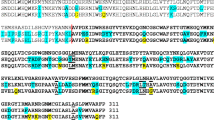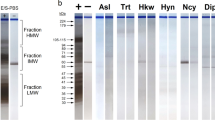Abstract
Cathepsin Ls (CatLs), the major cysteine protease secreted by Fasciola spp., are important for parasite digestion and tissue invasion. Fasciola gigantica cathepsin L1H (FgCatL1H) is the isotype expressed in the early stages for migration and invasion. In the present study, a monoclonal antibody (MoAb) against recombinant F. gigantica cathepsin L1H (rFgCatL1H) was produced by hybridoma technique using spleen cells from BALB/c mice immunized with recombinant proFgCatL1H (rproFgCatL1H). This MoAb is an immunoglobulin (Ig)G1 with κ light chain isotype. The MoAb reacted specifically with rproFgCatL1H, the native FgCatL1H at a molecular weight (MW) 38 to 48 kDa in the extract of whole body (WB) of metacercariae and newly excysted juvenile (NEJ) and cross-reacted with rFgCatL1 and native FgCatLs at MW 25 to 28 kDa in WB of 2- and 4-week-old juveniles, adult, and adult excretory–secretory (ES) fractions by immunoblotting and indirect ELISA. It did not cross-react with antigens in WB fractions from other parasites, including Gigantocotyle explanatum, Paramphistomum cervi, Gastrothylax crumenifer, Eurytrema pancreaticum, Setaria labiato-papillosa, and Fischoederius cobboldi. By immunolocalization, MoAb against rFgCatL1H reacted with the native protein in the gut of metacercariae and NEJ and also cross-reacted with CatL1 in 2- and 4-week-old juveniles and adult F. gigantica. Therefore, FgCatL1H and its MoAb may be used for immunodiagnosis of both early and late fasciolosis in ruminants and humans.





Similar content being viewed by others
References
Anuracpreeda P, Songkoomkrong S, Sethadavit M, Chotwiwatthanakun C, Tinikul Y, Sobhon P (2011) Fasciola gigantica: production and characterization of a monoclonal antibody against recombinant cathepsin B3. Exp Parasitol 127:340–345
Brady CP, Dowd AJ, Brindley PJ, Ryan T, Day SR, Dalton JP (1999) Recombinant, expression and localization of Schistosoma mansoni cathepsin L1 support its role in the degradation of host hemoglobin. Infect Immun 67(1):368–374
Chaithirayanon K, Wanichanon C, Vichasri GS, Ardseungneon P, Grams R, Viyanant V, Upatham ES, Sobhon P (2002) Production and characterization of a monoclonal antibody against 28.5 kDa tegument antigen of Fasciola gigantica. Acta Trop 84:1–8
Collins PR, Stack CM, O’Neill SM, Doyle S, Ryan T, Brennan GP, Mousley A, Stewart M, Maule AG, Dalton JP, Donnelly S (2004) Cathepsin L1, the major protease involved in liver fluke (Fasciola hepatica) virulence: propetide cleavage sites and autoactivation of the zymogen secreted from gastrodermal cells. J Biol Chem 279:17038–17046
Cordova M, Reatigui L, Espinoza JR (1999) Immunodiagnosis of human fascioliasis with Fasciola gigantica cysteine proteinases. Trans R Soc Trop Med Hyg 93:54–57
Dalton JP, Neill SO, Stack C, Collins P, Walshe A, Sekiya M, Doyle S, Mulcahy G, Hoyle D, Khaznadji E, Moiré N, Brennan G, Mousley A, Kreshchenko N, Maule AG, Donnelly SM (2003) Fasciola hepatica cathepsin L-like proteases: biology, function, and potential in the development of first generation liver fluke vaccines. Int J Parasitol 33(11):1173–1181
Delcroix M, Sajid M, Caffrey CR, Lim KC, Dvorák J, Hsieh I, Bahgat M, Dissous C, McKerrow JH (2006) A multienzyme network functions in intestinal protein digestion by a platyhelminth parasite. J Biol Chem 281:39316–39329
Dixit AK, Yodav SC, Sharma RL (2002) 28 kDa Fasciola gigantica cysteine proteinase in the diagnosis of prepatent ovine fasciolosis. Vet Parasitol 109:233–247
Estuningsih SE, Smooker PM, Wiedosari E, Widjajanti S, Vaiano S, Partoutomo S, Spithill TW (1997) Evaluation of antigens of Fasciola gigantica as vaccines against tropical fasciolosis in cattle. Int J Parasitol 27:1419–1428
Grams R, Vichasri-Grams S, Sobhon P, Upatham ES, Viyanant V (2001) Molecular and characterization of cathepsin L encoding genes from Fasciola gigantica. Parasitol Int 50:105–114
Itoh M, Sato S (1990) Multi-dot enzyme-linked immunosorbent assay for serodiagnosis of trematodiasis. Southeast Asian J Trop Med Public Health 21:471–474
Jefferies JR, Campbell AM, Rossum AJ, Barrett J, Brophy PM (2001) Proteomic analysis of Fasciola hepatica excretory-secretory products. Proteomic 1:1128–1132
Keiser J, Utzinger J (2005) Emerging foodborne trematodiasis. Emerg Infect Dis 11(10):1507–1514
Keiser J, Utzinger J (2009) Food-borne trematodiases. Clin Microbiol Rev 22(3):466–483
Krailas D, Viyanant V, Ardseungnoen P, Sobhon P, Upatham ES, Keawjam R (1999) Identification of circulating antibodies in fasciolosis and localization of 66 kDa antigenic target using monoclonal antibodies. Asian Pac J Allergy Immunol 17:53–58
Kueakhai P, Meemon K, Changklungmoa N, Chaithirayanon K, Reingrojpitak S, Sobhon P (2011) Characterization and localization of saposin-like protein-2 (SAP-2) in Fasciola gigantica. Parasitol Res 108:1493–1500
Kueakhai P, Changklungmoa N, Chaithirayanon K, Songkoomkrong S, Riengrojpitak S, Sobhon P (2013) Production and characterization of a monoclonal antibody against recombinant saposin-like protein 2 of Fasciola gigantica. Acta Trop 125:157–162
Maleewong W, Intapan PM, Wongkham C, Tomanakan K, Daenseekaew W, Sukeepaisarnjaroen W (1996) Comparison of adult somatic and excretory–secretory antigens in enzyme-linked immunosorbent assay for serodiagnosis of human infection with Fasciola gigantica. Southeast Asian J Trop Med Public Health 27:566–569
Maleewong W, Wongkham C, Intapan PM, Pipitgool V (1999) Fasciola gigantica-specific antigens: purification by a continuous-elution method and its evaluation for the diagnosis of human fascioliasis. Am J Trop Med Hyg 61:648–651
Mas-Coma S, Bargues MD, Esteban JG (1999) Human fasciolosis. In: Dalton JP (ed) Fasciolosis. CAB International Publishing, Wallingford, pp 411–434
Mas-Coma S, Bargues MD, Valero MA (2005) Fascioliasis and other plant-borne trematode zoonoses. Int J Parasitol 35:1255–1278
Meemon K, Grams R, Grams SV, Hofmann A, Korge G, Viyanant V, Upatham ES, Habe S, Sobhon P (2004) Molecular cloning and analysis of stage and tissue-specific expression of cathepsin B encoding genes from Fasciola gigantica. Mol Biochem Parasitol 136:1–10
Morphew RM, Wright HA, LaCourse EJ, Porter J, Barrett J, Woods DJ, Brophy PM (2011) Towards delineating functions within the Fasciola secreted cathepsin L protease family by integrating in vivo based sub-proteomics and phylogenetics. PLoS Negl Trop 5(1):e937
O’Neill SM, Parkinson M, Strauss W, Angles R, Dalton JP (1998) Immunodiagnosis of Fasciola hepatica infection (fasciolosis) in a human population in the Bolivian Altiplano using purified cathepsin L cysteine proteinase. Am J Trop Med Hyg 58:417–423
Rokni MB, Massoud J, Dalton JP (2002) Comparison of adult somatic and cysteine proteinase antigens of Fasciola gigantica in enzyme linked immunosorbent assay for serodiagnosis of human fascioliasis. Iran J Public Health 31:47–50
Sajid M, McKerrow JH (2002) Cysteine proteases of parasitic organisms. Mol Biochem Parasitol 120(1):1–21
Sansri V, Changklungmoa N, Chaichanasak P, Sobhon P, Meemon K (2013) Molecular cloning, characterization and functional analysis of a novel juvenile-specific cathepsin L of Fasciola gigantica. Acta Trop 128:76–84
Sethadavit M, Meemon K, Jardim A, Spithill TW, Sobhon P (2009) Identification, expression and immunolocalization of cathepsin B3, a stage-specific antigen expressed by juvenile Fasciola gigantica. Acta Trop 112:164–173
Shaheen HI, Kamal KA, Farid Z, Mansour N, Boctor FN, Woody JN (1989) Dot-enzyme linked immunosorbent assay (dot-ELISA) for the rapid diagnosis of human fascioliasis. J Parasitol 75:549–552
Shaheen H, al Khafif M, Farag RM, Kamal KA (1994) Serodifferentiation of human fascioliasis from schistosomiasis. Trop Geogr Med 46:326–327
Smith AM, Dowd AJ, McGonigle S, Keegan PS, Brennan G, Trudgett A, Dalton JP (1993) Purification of a cathepsin L-like proteinase secreted by adult Fasciola hepatica. Mol Biochem Parasitol 62:1–8
Tort J, Brindley PJ, Knox D, Wolfe KH, Dalton JP (1999) Proteinases and associated genes of parasitic helminthes. Adv Parasitol 43:161–266
Yadav SC, Saini M, Raina OK, Nambi PA, Jadav K, Sriveny D (2005) Fasciola gigantica cathepsin L cysteine proteinase in the detection of early experimental fasciolosis in ruminants. Parasitol Res 97:527–534
Acknowledgments
This research was supported by grants from the Faculty of Science, Mahidol University to Suda Riengrojpitak and Prasert Sobhon.
Author information
Authors and Affiliations
Corresponding author
Rights and permissions
About this article
Cite this article
Wongwairot, S., Kueakhai, P., Changklungmoa, N. et al. Monoclonal antibody against recombinant Fasciola gigantica cathepsin L1H could detect juvenile and adult cathepsin Ls of Fasciola gigantica . Parasitol Res 114, 133–140 (2015). https://doi.org/10.1007/s00436-014-4170-8
Received:
Accepted:
Published:
Issue Date:
DOI: https://doi.org/10.1007/s00436-014-4170-8




